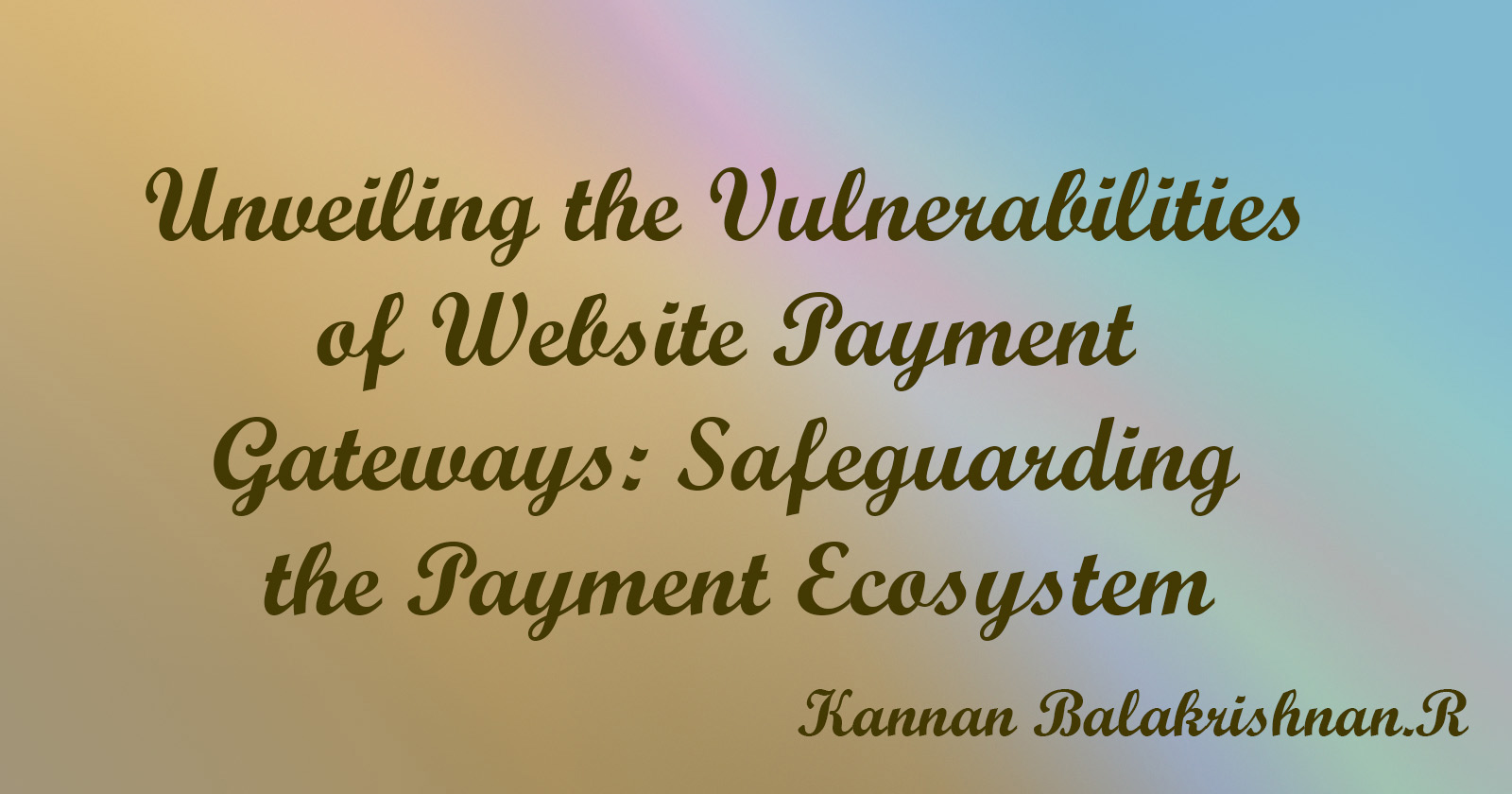Unveiling the Vulnerabilities of Website Payment Gateways: Safeguarding the Payment Ecosystem
 Kannan Balakrishnan R
Kannan Balakrishnan R
Introduction
The main focus of this article is on the vulnerabilities of website payment gateways. While many websites utilize simple and common payment gateways for their businesses, the question remains: Are these payment gateways secure? Payment gateway vulnerabilities can be classified into two distinct categories. The first category involves security risks within websites that enable hackers to acquire confidential information. The second category pertains specifically to vulnerable payment gateways.
In this discussion, we will focus on vulnerable payment gateways, as website security risks are specific to individual websites, whereas payment gateway risks impact the entire business ecosystem as well as the clients.
Payment Gateways
Typically, websites use two types of payment gateways: 2D payment gateways and 3D payment gateways. In layman's terms, a 2D gateway collects a user's credit card information and processes the payment, whereas a 3D gateway requires users to enter a one-time PIN or password to bypass the security verification.
2D gateways are common in the United States, Canada, and most European countries, while 3D gateways are prevalent in developing countries like India. Most fraudulent transactions occur through 2D secure payment gateways. The following section will explain how this happens.
Working Mechanism of credit card transaction
Credit cards contain secure information about users. Each credit card has 16 digits, an expiration date, the account holder's name, and a CVV or CVC code.
The first six digits of a credit card represent the Bank Identification Number (BIN). The BIN number indicates the bank that issued the card and its country or other relevant details. Anyone can obtain basic bank-related information by using just the BIN number.
When a user enters their credit card details in a payment portal, the system authenticates the information with the banking server. If the security verification is successful, the payment is deducted from the user's account. However, in the case of 2D secure gateways, the verification process involves checking the user's location using their IP address.
For instance, let's consider a person named Jimesh Sharma making an online transaction from his home. In this case, the 2D verification success rate is 100%. However, if Jimesh Sharma travels to another country and makes an online transaction, the payment verification success rate drops below 10% due to the location change. The background algorithm detects the person's location based on their IP address. But why is the success rate below 10%?
Some bank servers still rely on outdated security protocols, so they may authenticate such transactions as genuine, giving Jimesh Sharma a 10% chance of payment success.
Real Risk
It is crucial to safeguard credit card details since many people's information is still available in plain text on the internet. This leads to significant problems, as scammers exploit various methods to obtain credit card information, such as phishing websites, fake payment portals, and skimmer machines.
Possibilities of usage
Here, stolen credit card numbers are often sold or used to clone credit cards that appear identical to real ones. These cloned cards are then used at point-of-sale (POS) terminals and ATMs, or for making online purchases. In this discussion, we will focus specifically on online fraudulent purchases, where scammers utilize stolen credit card numbers on e-commerce websites, often with fake addresses. The question arises: How do they successfully bypass the security verification algorithm?
They will always mask their IP addresses to remain invisible on the internet. They typically use SOCKS4 or SOCKS5 proxies from the credit card owners' nearest locations. SOCKS5 is a proxy IP that provides high-precision anonymity when browsing the internet. These scammers employ multiple layers of IP masking to completely hide their information. They change various aspects of their PCs, such as location and time zone, to enhance their anonymity.
Many scammers employ remote desktop protocols, such as Amazon Web Services (AWS) and Google Cloud Compute Engine, for illegal activities. They utilize these services to maintain a high level of anonymity.
Conclusion
As mentioned earlier, numerous fraudulent transactions occur through the 2D verification process. Therefore, in conclusion, 2D secure gateways may not be suitable in all cases. While some payment gateways attempt to mitigate these fraudulent transactions by initiating chargebacks, the consequences still impact business owners. Ultimately, the profit tends to favor the scammers rather than the legitimate business owners. Safeguarding credit card details and implementing robust security measures is crucial to protect against these vulnerabilities and ensure a secure payment ecosystem.
Subscribe to my newsletter
Read articles from Kannan Balakrishnan R directly inside your inbox. Subscribe to the newsletter, and don't miss out.
Written by

Kannan Balakrishnan R
Kannan Balakrishnan R
I am a web developer and cybersecurity enthusiast. I will share my knowledge through articles focusing on updated, trending technology-related topics.